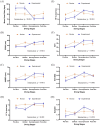Autonomic and physiological stress responses in navy divers: the protective role of diving experience
- PMID: 40901610
- PMCID: PMC12399529
- DOI: 10.3389/fphys.2025.1642779
Autonomic and physiological stress responses in navy divers: the protective role of diving experience
Abstract
Introduction: Deep diving presents significant physiological stress, yet reliable indicators for monitoring autonomic and stress responses remain underdeveloped. This study examined how prior deep diving experience influences autonomic regulation and stress biomarkers during a simulated dive to a depth of 220 feet.
Methods: Twenty-eight Navy divers (15 experienced, 13 novice) underwent psychological assessments (perceived stress, anxiety, fear) and salivary biomarker analysis (cortisol, amylase) pre- and post-dive. Heart rate variability (HRV), including linear (rMSSD, HF) and non-linear indices (SD1, SD1/SD2, sample entropy), was measured at four dive stages (pre-dive, bottom, decompression, and post-dive).
Results: After adjusting for age and perceived stress, experienced divers exhibited greater post-dive reductions in cortisol (p = 0.015) and amylase (p = 0.022). Additionally, after controlling for age, perceived stress, and respiratory rate, they also demonstrated significantly higher parasympathetic activity (p ≤ 0.001) and greater HRV complexity (sample entropy, p = 0.023) during decompression. No significant differences were found in self-reported psychological stress.
Discussion: Diving experience facilitates enhanced autonomic control and stress adaptation. These findings support the use of real-time physiological monitoring and experience-based training protocols to mitigate risk during deep dives.
Keywords: amylase activity; autonomic nervous system; deep diving; heart rate variability; psychological distress; salivary cortisol.
Copyright © 2025 Chen, Tzeng, Tang, Li, Wu and Huang.
Conflict of interest statement
The authors declare that the research was conducted in the absence of any commercial or financial relationships that could be construed as a potential conflict of interest.
Figures


Similar articles
-
Extremely deep bounce dives: planning and physiological challenges based on the experiences of a sample of French-speaking technical divers.Diving Hyperb Med. 2025 Jun 30;55(2):203-210. doi: 10.28920/dhm55.2.203-210. Diving Hyperb Med. 2025. PMID: 40544151 Free PMC article.
-
Evaluation of North Sea saturation procedures through divers monitoring.Int Marit Health. 2024;75(2):89-102. doi: 10.5603/imh.99606. Int Marit Health. 2024. PMID: 38949219
-
Modelling the risk factors for accidents in recreational divers: results from a cross-sectional evaluation in Belgium.Diving Hyperb Med. 2024 Dec 20;54(4):287-295. doi: 10.28920/dhm54.4.287-295. Diving Hyperb Med. 2024. PMID: 39675736
-
The role of cognition as a factor regulating the diving responses of animals, including humans.J Exp Biol. 2024 Oct 15;227(20):jeb246472. doi: 10.1242/jeb.246472. Epub 2024 Aug 23. J Exp Biol. 2024. PMID: 39177084 Review.
-
The Impact on Autonomic Nervous System Activity during and Following Exercise in Adults: A Meta-Regression Study and Trial Sequential Analysis.Medicina (Kaunas). 2024 Jul 28;60(8):1223. doi: 10.3390/medicina60081223. Medicina (Kaunas). 2024. PMID: 39202504 Free PMC article.
References
-
- Bai Y., Selvaraj N., Petersen K., Mahon R., Cronin W. A., White J., et al. (2013). The autonomic effects of cardiopulmonary decompression sickness in swine using principal dynamic mode analysis. Am. J. Physiol. Regul. Integr. Comp. Physiol. 305 (7), R748–R758. 10.1152/ajpregu.00150.2012 - DOI - PubMed
LinkOut - more resources
Full Text Sources
Research Materials
Miscellaneous

